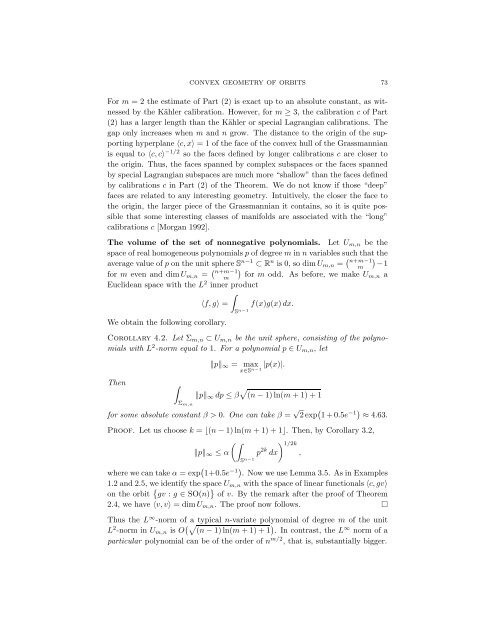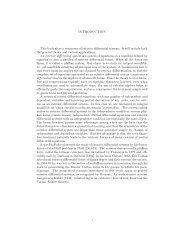You also want an ePaper? Increase the reach of your titles
YUMPU automatically turns print PDFs into web optimized ePapers that Google loves.
CONVEX GEOMETRY OF ORBITS 73<br />
For m = 2 the estimate <strong>of</strong> Part (2) is exact up to an absolute constant, as witnessed<br />
by the Kähler calibration. However, for m ≥ 3, the calibration c <strong>of</strong> Part<br />
(2) has a larger length than the Kähler or special Lagrangian calibrations. The<br />
gap only increases when m and n grow. The distance to the origin <strong>of</strong> the supporting<br />
hyperplane 〈c,x〉 = 1 <strong>of</strong> the face <strong>of</strong> the convex hull <strong>of</strong> the Grassmannian<br />
is equal to 〈c,c〉 −1/2 so the faces defined by longer calibrations c are closer to<br />
the origin. Thus, the faces spanned by complex subspaces or the faces spanned<br />
by special Lagrangian subspaces are much more “shallow” than the faces defined<br />
by calibrations c in Part (2) <strong>of</strong> the Theorem. We do not know if those “deep”<br />
faces are related to any interesting geometry. Intuitively, the closer the face to<br />
the origin, the larger piece <strong>of</strong> the Grassmannian it contains, so it is quite possible<br />
that some interesting classes <strong>of</strong> manifolds are associated with the “long”<br />
calibrations c [Morgan 1992].<br />
The volume <strong>of</strong> the set <strong>of</strong> nonnegative polynomials. Let Um,n be the<br />
space <strong>of</strong> real homogeneous polynomials p <strong>of</strong> degree m in n variables such that the<br />
average value <strong>of</strong> p on the unit sphere Sn−1 ⊂ Rn is 0, so dimUm,n = � � n+m−1<br />
m −1<br />
�<br />
for m odd. As before, we make Um,n a<br />
for m even and dimUm,n = � n+m−1<br />
m<br />
Euclidean space with the L2 inner product<br />
�<br />
〈f,g〉 = f(x)g(x)dx.<br />
We obtain the following corollary.<br />
S n−1<br />
Corollary 4.2. Let Σm,n ⊂ Um,n be the unit sphere, consisting <strong>of</strong> the polynomials<br />
with L 2 -norm equal to 1. For a polynomial p ∈ Um,n, let<br />
Then �<br />
Σm,n<br />
�p�∞ = max<br />
x∈Sn−1 |p(x)|.<br />
�p�∞ dp ≤ β � (n − 1)ln(m + 1) + 1<br />
for some absolute constant β > 0. One can take β = √ 2exp � 1+0.5e −1� ≈ 4.63.<br />
Pro<strong>of</strong>. Let us choose k = ⌊(n − 1)ln(m + 1) + 1⌋. Then, by Corollary 3.2,<br />
��<br />
�p�∞ ≤ α p 2k �1/2k dx ,<br />
S n−1<br />
where we can take α = exp � 1+0.5e −1� . Now we use Lemma 3.5. As in Examples<br />
1.2 and 2.5, we identify the space Um,n with the space <strong>of</strong> linear functionals 〈c,gv〉<br />
on the orbit � gv : g ∈ SO(n) � <strong>of</strong> v. By the remark after the pro<strong>of</strong> <strong>of</strong> Theorem<br />
2.4, we have 〈v,v〉 = dimUm,n. The pro<strong>of</strong> now follows. ˜<br />
Thus the L ∞ -norm <strong>of</strong> a typical n-variate polynomial <strong>of</strong> degree m <strong>of</strong> the unit<br />
L 2 -norm in Um,n is O �� (n − 1)ln(m + 1) + 1 � . In contrast, the L ∞ norm <strong>of</strong> a<br />
particular polynomial can be <strong>of</strong> the order <strong>of</strong> n m/2 , that is, substantially bigger.




